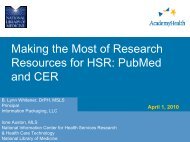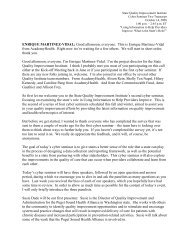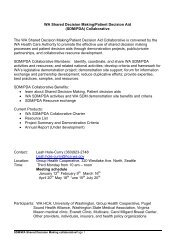Ohio Health Quality Improvement Plan
Ohio Health Quality Improvement Plan
Ohio Health Quality Improvement Plan
You also want an ePaper? Increase the reach of your titles
YUMPU automatically turns print PDFs into web optimized ePapers that Google loves.
Pa y m e n t Re f o r mThe purpose of payment reform is to transform public and private payment systems inorder to improve the value of health care spending.Improve the quality and efficiency of patient care and reduce health care costs by adopting and implementing payment modelsto support medical homes, health promotion, patient safety and more efficient business processes and delivery of care for all<strong>Ohio</strong>ans.Benefits• Patient health, safety and care will improve, particularly in prevention and management of chronic conditions.• More primary care practices will adopt the patient centered medical home model leading to improved patient health,culturally competent care and improved outcomes.• <strong>Health</strong> care will be better coordinated, decreasing the need for hospitalizations for conditions that should be appropriatelymanaged in ambulatory settings.• More providers will adopt electronic medical records and e-prescribing, decreasing the likelihood of unnecessary care andavoidable adverse events.• Cost effective care, such as the use of generic drugs, will be incentivized.• Expenditures for redundant tests, inappropriate care, and avoidable adverse events will decrease.• Administrative costs will be reduced through efficiencies created by electronic billing and electronic eligibility verification.TacticsTactic 1: Identify and recommend payment models to support patient centered medical homes (PCMH) and develop paymentmethodologies (e.g. fee for service with incentives/disincentives, reimbursement bundling based on episodes of care, outcomesbased reimbursement, capitation, etc.).• The Coverage and <strong>Quality</strong> Council should appoint a stakeholder group of payers, professional organizations and agenciesto evaluate and agree upon payment reform models to support PCMHs and to create metrics for quality and transparentoutcomes. The stakeholder group should:◦◦ Work with the PCMH group to define critical elements in the PCMH that should be reimbursed;◦◦ Work with the PCMH group to develop strategies to build workforce capacity such as providing partial loan forgivenessto new physicians and nurse practitioners who choose to become primary care providers in underserved areas and withunderserved populations;◦◦ Identify and evaluate available PCMH payment models;◦◦ Confer with national PCMH payment reform experts as to available models;◦◦ Decide what to measure on payment reform for PCMH on quality, cost savings and reduction of disparities;◦◦ Develop metrics and outcomes measures for the effectiveness of payment models;◦◦ Develop payment models for all <strong>Ohio</strong> payers to encourage statewide adoption of PCMHs;◦◦ Determine how to document savings, how to “capture savings,” and how to share savings in PCMHs; and◦◦ Collect and analyze data on cost and quality in other parts of the health delivery system and develop recommendationsneeded for improvements, including metrics related to identifying outcomes affecting disparate populations.Tactic 2: Design financial incentives to promote e-prescribing, e-health records, e-billing and electronic eligibility verification.• The Coverage and <strong>Quality</strong> Council should appoint a stakeholder group focused on payment reform to support e-healthrecords, e-billing and electronic eligibility verification. The stakeholder group should:◦◦ Work with the HIT group to develop strategies for financial and technical assistance to encourage use of e-healthrecords, e-billing and electronic eligibility verification;◦◦ Work with the HIT group to ensure that HIT initiatives include education and incentives for providers to collect data tosupport population health initiatives that address health disparities and chronic disease;◦◦ Identify private funding sources to help small providers and providers in underserved areas obtain technology;◦◦ Recommend changes to Medicaid regulations to encourage e-billing;◦◦ Develop and recommend private payer incentives for e-health records, e-billing and electronic eligibility verification;◦◦ Identify or develop grant and/or loan opportunities to help small providers and providers in underserved areas acquirethe hardware to enable the e-health records, e-transmission of claims and electronic eligibility verification;14










